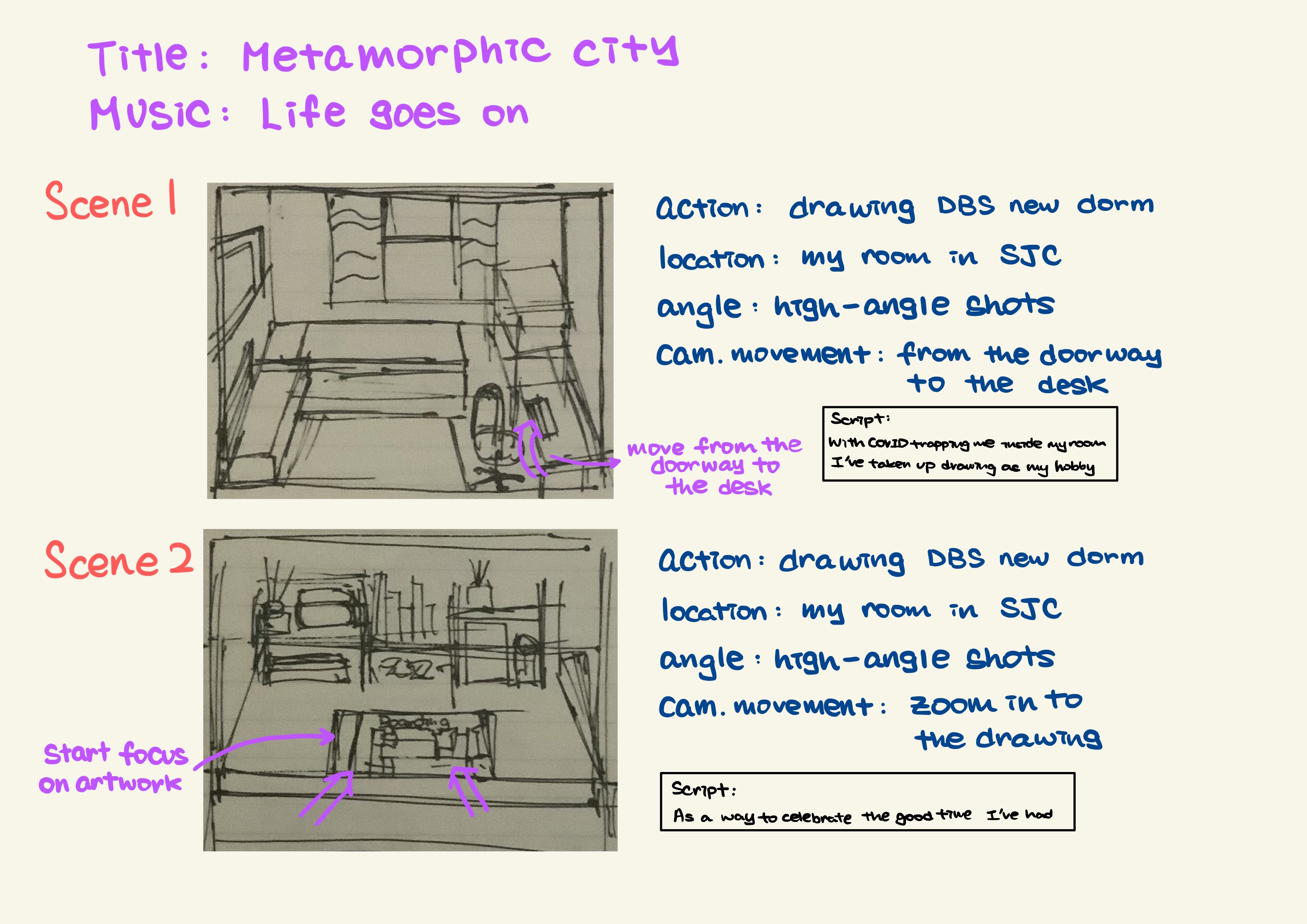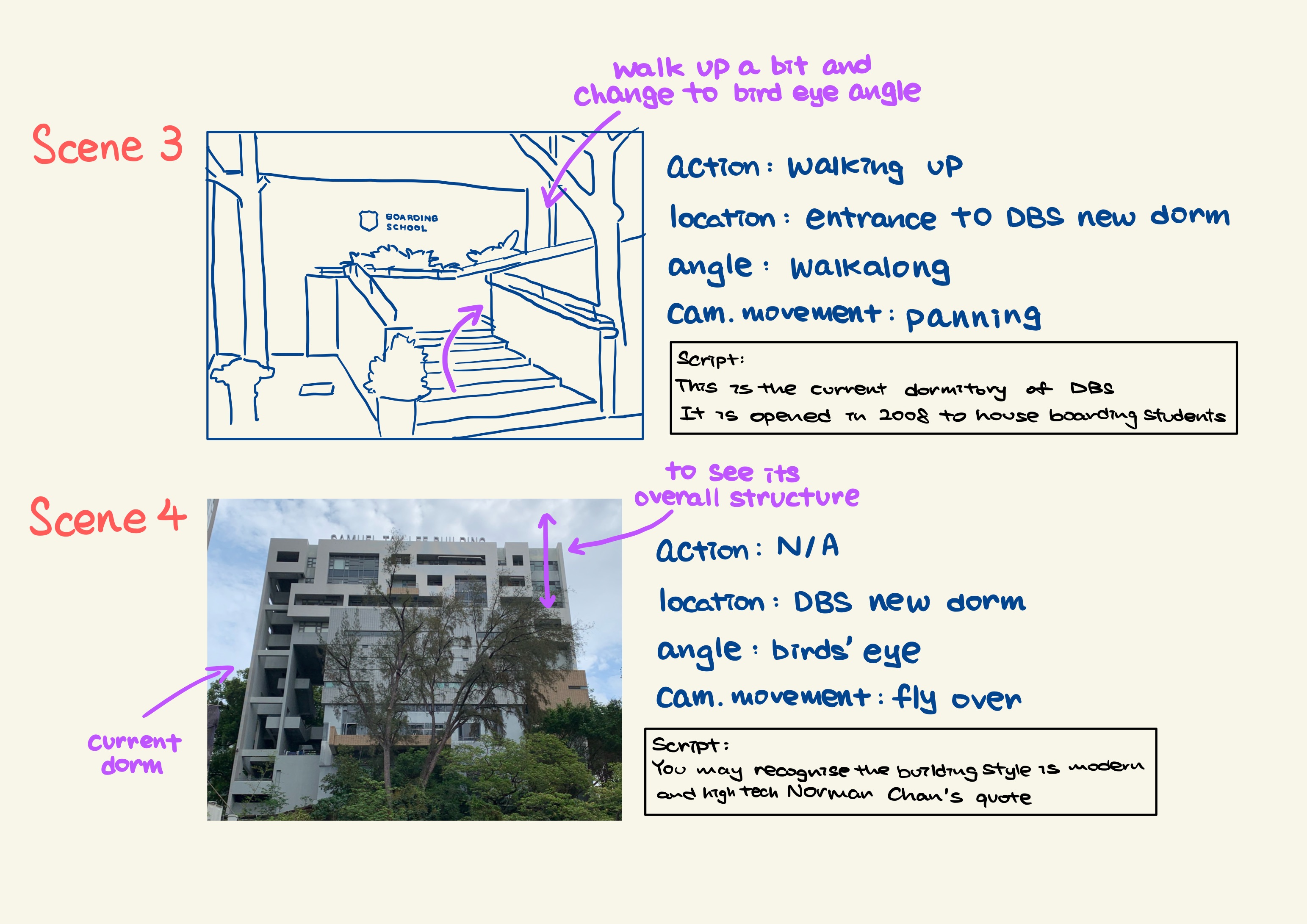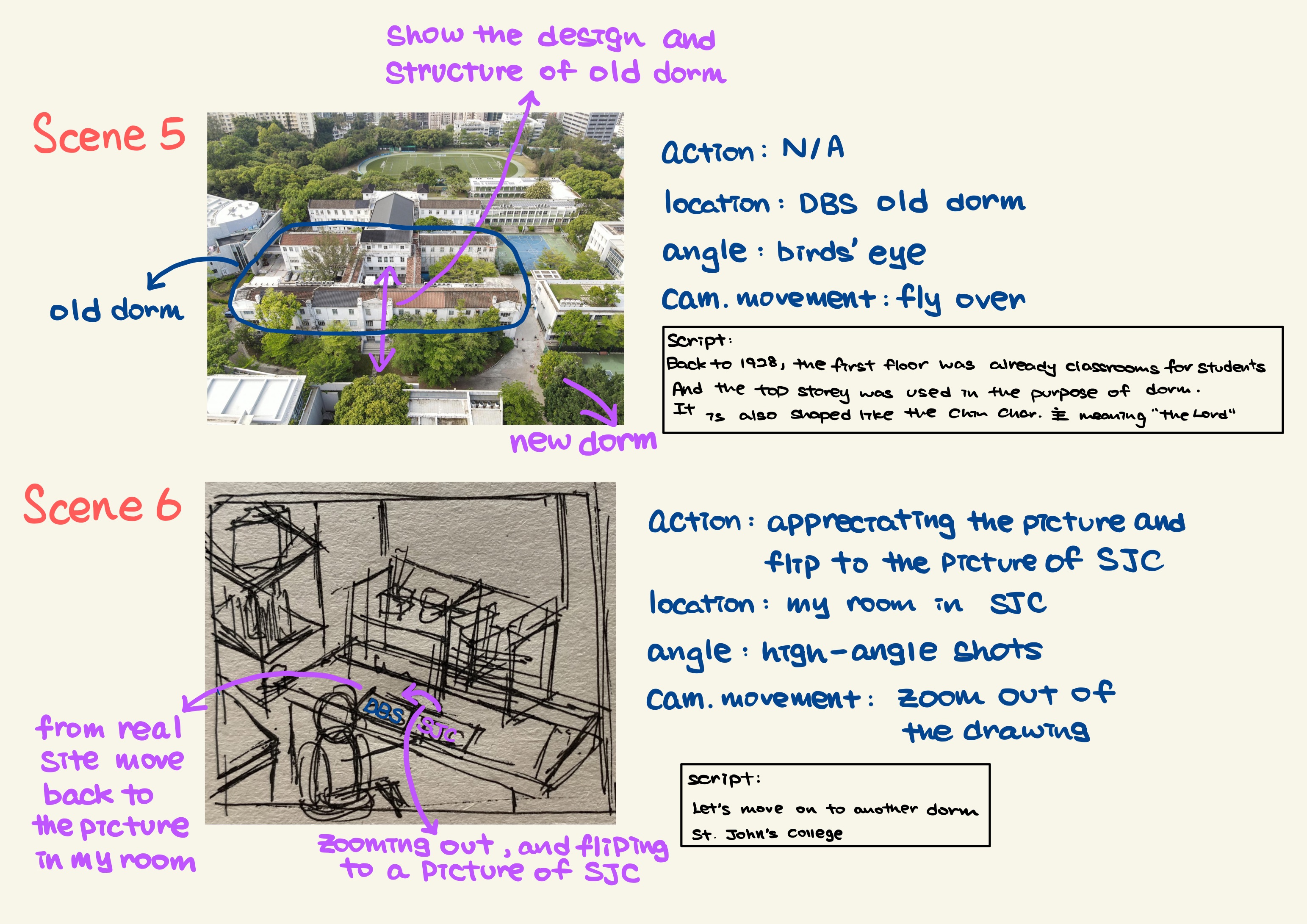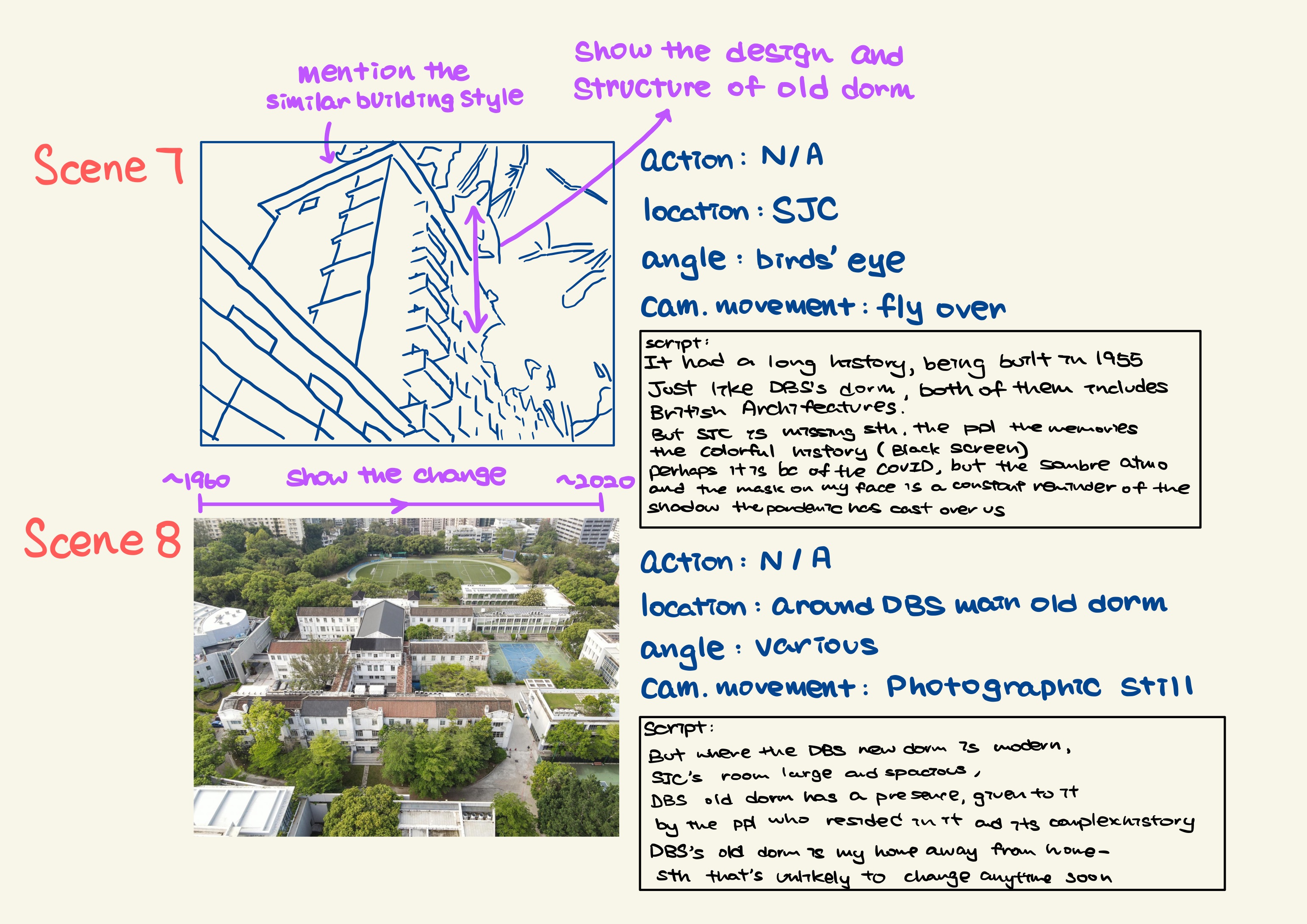Story Board: 



Description:
Diocesan Boys’ School’s dormitories are on its main campus- a fairly uncommon sight in a city as pressed for space as Hong Kong is. There are two different dormitories, one of them for the teaching staff and another one for students. “It is an interesting mix of historic colonial buildings right next to these very modern buildings: it gels together,” Norman Chan, a famous Hong Kong architect once said. Due to the COVID-19 pandemic, both are mostly empty as their occupants have returned home. Those remaining are the ones taking DSE or non-local students – the dormitory being their only refuge at the moment. The laughter has become sombre due to COVID-19, the people have changed from time to time, but the memories I have here will never change. The teacher’s dormitories take after colonial-style buildings as DBS, which was established in 1869, was built in 1928. During the second world war, it was also treated as hospitals for the Japanese. The top storey of the main building were dormitories for the students and the first floor are classrooms before the new dormitory was built. The main building has not changed much ever since, but you can also feel the difference comparing photos showing the past and the current. This feeling can be described using Ackbar Abbas’ reading in lecture 2 “unfamiliar in the familiar, that is, the unfamiliar that is half-seen or seen subliminally behind the seen/scene of the familiar”. The feeling that old boys experience is this paradoxical idea, as well as revealing this sense of emptiness and hollowness despite being in an environment that one is comfortable with. Undoubtedly, Diocesan Boys’ School, especially the dormitory, will always generate a sense of belonging in old boys. Over time, however, coming back to this place will definitely bring about different feelings. The change is not in the appearance of the place but the people inside. From the design of this building, you can also see the building style is trending towards the modern with traces of mies and le corbusier rather than staying in the colonial style. Ackbar Abbas also mentioned that the more placeless and commercial the buildings, the more the urban vernacular remains anonymous and characterless. The old dormitory incorporates both British architectural features (a green lawn and roundabout typically located at the front porch of British villas) and Chinese courtyard layouts. It is also shaped like the Chinese character “主” which means “The Lord”. Moving to the St. John’s College dormitory, it has had a long history, being founded in 1912 and was built in 1955, while the DBS’s old student dormitory has been in existence for a mere 25 years. Through much of DBS, Abbas mentions this when he talks about the urban vernacular and how the commercialization and placelessness of buildings have made it anonymous and characterless. Despite having lived there the longest, I’ve never come to appreciate the rather bland new DBS dormitory, where it has always been more about the people than anything. That leaves the two others with their unique building style, which always leaves me marvelling at the simplistic yet elegant architecture. But the DBS main building, with its sprawling construction and rich history, is just that little more special to me. The video walks through my time spent in the two dormitories. the shift in building style across the three dormitories and by extension, in Hong Kong and across the world.
Research and Construction:
My first research was to apply the meaning of a metamorphic city. The general idea refers to the city with different forms and styles of building and all of them are having their special features. In fact, even a small place in Hong Kong like Diocesan Boys’ School can already tell the story. Firstly, there are already two totally different forms of dormitories in Diocesan Boys’ School, they have an advanced, modern and high-tech one, but at the same time, there also appears to have a very traditional and colonial-style former dormitory. Lots of history and information could be found in the book To Serve and to Lead: History of the Diocesan Boys’ School in Hong Kong and some of the books and documentary books in the Diocesan Boys’ School Museum. Moving on to the St. John’s College part, the reason for adding this part is to compare it with the colonial building style with the Diocesan Boys’ School old dormitory. Both of them are in colonial building style, but one of them was built in 1928 and another one was built in 1955. For this part, it is really hard to read a book to tell you everything as people inside usually keep many things as secret, and I have the chance to listen to the story as I am one of the residents.
Video Production:
The whole video follows the things that I will do late at night, like drawing pictures, throwing back to the old good time, and looking at the pictures of some remarkable places. In video making, I filmed three different dormitories, Diocesan Boys’ School old dormitory (currently the main building), Diocesan Boys’ School current dormitory and St. John’s College. Since it is impossible to go back to the 1920s to film the very original Diocesan Boys’ School old dormitory to show in my video, I decide to use drones to film the current outlook. I also add filters to some of the pictures to make them looks more like in the 1920s and the 1970s and all filters added are based on some documentary videos in the DSOBA YouTube channel and in DBS private gallery. Lastly, the ending of my story talks about the term “Home” as well because once people live or stay longer in that place, it is easy to develop that sense of belonging, even to a dormitory. You might recognise that every time when it moves to the real site of the place, the footages are cropped. This is inspired by a movie called “The Mauritanian”. In the movie, every time they mention something in the past, they will use squared shots to indicate that is a past issue.
Background music:
BTS (방탄소년단) – Life Goes On (Piano Cover)
Reference:
Abbas, M. A. (1997). Hong Kong: Culture and the politics of disappearance (pp. 63-90). University of Minnesota Press. http://www.jstor.org/stable/10.5749/j.ctttshbm.7
Cheung, E. (2020, August 7). The secrets of Diocesan Boys’ School’s success at nurturing generations of Hong Kong talent. South China Morning Post. https://www.scmp.com/native/news/hong-kong/education/topics/own-legacy-kadoorie-hill/article/3086949/secrets-diocesan
DSOBA Official (2021, April 22). S for Serving (2:29-2:31). DSOBA Official YouTube Channel. https://www.youtube.com/watch?v=ZcJKdmclwYM
Lu, D. (2008). HKIA Annual Awards 2017. Dormitory & Sports Facilities at Diocesan Boys’ School (pp.32-35). Hong Kong Institute of Architects. http://www.building.com.hk/forum/2008_0711hkia.pdf
St. John’s College (2017). Relocation to the Present Address and a New Mission. St. John’s College. https://www.stjohns.hk/about-st-johns/history/
Wang, F., & Moira, C. (2009). School Life. To Serve and to Lead: History of the Diocesan Boys’ School in Hong Kong (pp. 215-244). Hong Kong University Press. http://www.jstor.org/stable/j.ctt2jc0jz.15
Leung Kwan Ho Gordon, 3035778022
I’m really amazed by your filming skills. I can see that you have put a lot efforts in preparing the video. The drawings and the angle from the sky are really impressive. You have showed the audiences the not only the structural feature of the buildings but also the historical features. At different times, the use of it is different. The changing of its features remind me that what we are now going through–pandemic, is an important historical event as well as world was two and the colonial history of Hong Kong.
It is really enjoyable to watch your video. This is my first time seeing the DBS and St. John’s College dormitory and knowing the prolonged history behind it. I can see that you have put a lot of effort into preparing the storyboard, especially the amazing storyboard drawings. The usage of drone footage from different angles helps a lot in showing the structure and architectural features of these three dormitories, creating contrast within them. Your video also reminds me of the impact the pandemic brought to our city, where the distance between people furthered. It would be great if you add some videos showing the original energetic dormitories so that the comparison will be more comprehensive. All in all, you made a successful film with a clear narration and message to viewers.
The way you weaved drone footage and video sections in your room together made the video an excellent story-telling experience, and the transitions were extremely well made. Combined with your choice of music and heartfelt dialog, the strong solidarity you feel for your school is readily apparent. Your addition of historical information and analysis also elevates the story beyond the personal level and makes us the viewers reflect upon the impact that events like WWII and the pandemic has had on us. Overall, an extremely well-made video!
Well-done for producing such well-researched video on dormitories! Perhaps “polymorphic” might be a better adjective for your title than “metamorphic” if it is referring to the city. All aspects are addressed and presented with insightful depth. The video and voice-over demonstrates a clear understanding of and the ability to apply and synthesise research, concepts and key issues relating to a well-identified topic. You were able to clearly identify the most critical aspects of the places and present an original interpretation of the topic. You maintained an excellent control of techniques and organisation of the content and narration – the editing is great. The written and verbal articulation are of high academic standard, and well integrated into the overall presentation.